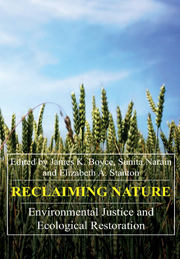Book contents
- Frontmatter
- Contents
- List of Figures and Tables
- Acknowledgements
- Introduction
- Part I ADDING VALUE
- 1 The Blessing of the Commons: Small-Scale Fisheries, Community Property Rights, and Coastal Natural Assets
- 2 Natural Resource Management and Poverty Alleviation in Mountain Areas
- 3 Harvesting the Rain: Fighting Ecological Poverty through Participatory Democracy
- 4 Net Benefits: The Ecological Restoration of Inland Fisheries in Bangladesh
- Part II DEMOCRATIZING ACCESS
- Part III CAPTURING BENEFITS
- Part IV DEFENDING THE COMMONS
- About the Contributors
- Index
3 - Harvesting the Rain: Fighting Ecological Poverty through Participatory Democracy
from Part I - ADDING VALUE
Published online by Cambridge University Press: 05 March 2012
- Frontmatter
- Contents
- List of Figures and Tables
- Acknowledgements
- Introduction
- Part I ADDING VALUE
- 1 The Blessing of the Commons: Small-Scale Fisheries, Community Property Rights, and Coastal Natural Assets
- 2 Natural Resource Management and Poverty Alleviation in Mountain Areas
- 3 Harvesting the Rain: Fighting Ecological Poverty through Participatory Democracy
- 4 Net Benefits: The Ecological Restoration of Inland Fisheries in Bangladesh
- Part II DEMOCRATIZING ACCESS
- Part III CAPTURING BENEFITS
- Part IV DEFENDING THE COMMONS
- About the Contributors
- Index
Summary
Introduction
In many parts of the developing world, poverty is not so much about a lack of money as a lack of natural resources. For rural people who live off the land, prosperity means plenty of water, crops, animals and timber. Improving the ‘gross natural product’ is far more important than increasing the gross national product (Agarwal 1985). Building and sustaining a base of natural capital is the key to a robust local economy.
This chapter presents case studies of four rural communities in India that have succeeded in mobilizing natural and human capital to generate economic wealth and well-being through improved management of natural resources. All four studies come from hilly and plateau regions of India, with semi-arid to sub-humid climates (500–1,250 millimetres of rainfall per year). In all cases, important natural resources are held as common property. From the colonial era until recently, these resources were managed, or mismanaged, by government agencies. The key to ecological restoration has been the restoration of community control.
In these regions, watershed management requires cooperative solutions above the level of the individual farm. The ancient art of water harvesting needs to be revived and modernized to provide adequate water for irrigation and household needs. Water harvesting means capturing the rain where it falls by collecting runoff from rooftops, constructing check dams and small reservoirs to capture runoff from local catchments, and replanting degraded watersheds, so as to reduce runoff losses.
- Type
- Chapter
- Information
- Reclaiming NatureEnvironmental Justice and Ecological Restoration, pp. 89 - 110Publisher: Anthem PressPrint publication year: 2007
- 1
- Cited by



